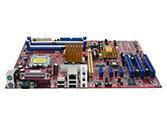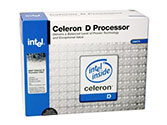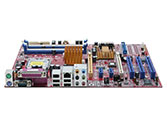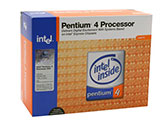Entry Level Buyer’s Guide, July 2005
by Jarred Walton on July 20, 2005 12:05 AM EST- Posted in
- Guides
Intel Recommendations
Not a whole lot has changed in the budget Intel market. Intel has had PCIe graphics for a while now, and we're still waiting for newer Celeron and Pentium chips with 64-bit support. (We're also waiting for Semprons with 64-bit support, though really we're not too concerned about the 64-bit factor for budget systems.)  |
 |
| Click images to enlarge. | |
Budget 775 Motherboard: Biostar I915P-A7
Price: $79 shipped
Budget 775 CPU: Intel Celeron D 330J 2.66GHz 256K L2 (Retail)
Price: $85 shipped (Retail)
Total: $164
Almost exactly matching the budget AMD setup in price, we continue with similar recommendations to our last budget Guide. The choice of CPU is less about performance than price, but the difference between the 2.53 GHz 325 and the 2.66 GHz 330J is only $4, so we go with the upgraded processor. You can see the complete list of Celeron prices on our Price Engine, and the next model up from the 330J adds $15, which is more than we're willing to pay for a budget setup.
The motherboard choice is the cheapest 775 motherboard that we could find with a few qualifications. First, it needs to be a PCI Express board, which generally means the 915P or 915G chipset. We avoid the 915GV chipset as that reduces performance by only supporting single-channel memory. The other requirement is that the board needs to have 4 DIMM slots of the same type, and for now, that means DDR. Some people may not mind the hybrid boards, but we like to have the ability to run 4x512MB of RAM in the future. The Biostar I915P-A7 fits all of those requirements and comes in substantially cheaper than most other competitors. Biostar also offers the I915G-M7 for those who want integrated graphics - as a business solution or a standby until you can add in a decent graphics card, the extra $6 is a good deal.
The only other boards that are priced similarly are from Jetway (915PCP/GCP), ECS (915G-M), Foxconn (915G7MC-S), and Aopen (i915Pa-E) - we may have missed one or two boards, but the point is that there aren't any name brands like ASUS or MSI in this price range. None of these are really better than the Biostar in our opinion, and they all cost a bit more.
If you like the idea of integrated graphics but want more performance, the ASUS P5RD1-V uses the ATI Xpress 200 chipset and may be worth consideration. The price of $100 makes it a moderately expensive upgrade, and if you're looking at an IGP solution you probably don't care much that the Xpress 200 is twice as fast in several gaming benchmarks - a discrete graphics card will still outperform the IGP with relative ease. As with the MSI Xpress 200 board for AMD, we don't expect much in the way of overclocking due to the chipset. Overclockers should probably look to the more recognized enthusiast brands like ASUS, DFI, MSI, etc. and get an Intel chipset, though you'll also have to pay over $100 for those.
 |
 |
| Click images to enlarge. | |
Upgraded 775 Motherboard: Biostar I945P-A7
Price: $98 shipped
Upgraded 775 CPU: Intel Pentium 505 533 FSB (Retail)
Price: $134 shipped (Retail)
Total: $232
Our upgraded Intel platform takes a bit different approach than the past. Price is once again equal to the AMD side of things, but we spend more on the motherboard and less on the CPU. We cut the CPU from the Pentium 520 of previous Guides (2.8 GHz 800FSB with HyperThreading) to the 505 (2.66 GHz 533FSB and no HyperThreading). HTT is sort of interesting, but the extra $40 to upgrade to the 520 is pretty significant. Actually, the 530J is only a couple of dollars more than the 520, so if you do go for the faster processor, the 530J is the better buy. Performance of the 505 is reasonable, though clearly outclassed by the Athlon 64 processors. Part of the reason why we like the 505 is that you can get some great overclocking results from it on virtually any motherboard. The processor has a 20X multiplier, so combined with a bus speed of 166 to 200, you can shoot for 3.33 GHz to 4.0 GHz. The upper end of that range may be difficult to reach, but 3.4 to 3.6 GHz is pretty reasonable for the 90nm Prescott design.
Along with the switch to a slightly slower CPU, we've included the cheapest DDR2 board that we could find for future compatibility, and it also uses the new 945P chipset. The switch to DDR2 will increase the price slightly relative to DDR, but even AMD will be moving to DDR2 early next year, so you should be able to use the RAM in a future system. Integrated graphics versions of the chipset are also available with the 945G series, with the most affordable options coming from ASUS (P5LD2-VM) and Intel themselves. The cheapest 945G models are micro ATX form factors, allowing the use of a smaller case like the Aspire X- QPack that we recently reviewed, as well as any other uATX case. (You can always put the small motherboard in a full-size ATX case if you prefer.)
The 945 chipsets all support dual core CPUs, providing another future upgrade path. With the cheapest Pentium D starting at well over $200, we can't recommend such a CPU for a budget system yet, but we expect prices to drop over the coming year, making it a viable upgrade in 2006. If you go with the budget Intel recommendation, you're stuck with single core processor support for as long as you own the system. Of course, some people never upgrade individual components and prefer to replace the entire system every few years. If that describes your purchasing habits, there's not much point in buying more future-proof components.










57 Comments
View All Comments
bob661 - Wednesday, July 20, 2005 - link
Thanks Jarred.JarredWalton - Wednesday, July 20, 2005 - link
#15 - Bob,OCZ has quite a few overlapping RAM offerings these days, all of which have a place. I recommended the BH5 based Gold that runs 2-2-2-5 1T at 2.8V as opposed to the VX offering that requires 3.2V for 2-2-2-5 1T. Here's the link:
http://www.ocztechnology.com/products/memory/ocz_e...
You can also find the RAM at Newegg:
http://www.newegg.com/Product/Product.asp?Item=N82...
The VX is about the same price, but it doesn't have "Gold" in the name.
----------
WRT the displays, I would much rather have a larger display. Getting people to go from $600 for the basic setup to $750 for a 19" LCD is a tough sell, unfortunately. I really like 19" LCDs (and I like my 2405FPW even more), but few people are willing to shell out over $300 for "just the display". As Hacp mentions, a lot of people just don't realize what they're missing. I know plenty of people with 17" to 19" displays that still run them at 1024x768 - even on LCDs. They just don't realize that resolution is something most people should adjust.
SDA - Wednesday, July 20, 2005 - link
#31, I'm not sure where to start with you.First: Anyone can see the difference between 17" and 19".
Second: You won't notice any difference between a fast system and a (reasonably) slow system when watching movies, writing letters, or surf the web. otoh, you WILL notice a difference between a good monitor and a bad monitor when playing games and editing photos. You're using your monitor every time you're at your computer, but most of the time you don't need a fast CPU at all.
Third: Image quality is important. If image quality wasn't important, people wouldn't buy high-end video cards for games.
IME, people who place I/O equipment (monitor, mouse, sound setup, etc.) at the bottom of the list do so because they have never used genuinely good I/O equipment for any reasonable length of time. I don't mean any offense here, this is just what I've seen.
Zebo - Wednesday, July 20, 2005 - link
sprockkets - just the opposite.. prescott uses about 30% more power than a northwood at same hurtz.. and really starts leaking like crazy after 3.4 which a northwood never saw.Zebo - Wednesday, July 20, 2005 - link
Bob - http://forums.anandtech.com/messageview.aspx?catid...Hacp - Wednesday, July 20, 2005 - link
I doubt that a budgetminded person would recognize the difference between 19 and 17 inches much. Heck, I would even go for a 15 inch LCD if it gave room to get a better video card/cpu or more ram. Screen size is the last thing I think about when I budget for a comptuer.Wellsoul2 - Wednesday, July 20, 2005 - link
The Polywell LCD is a good one but I would go witha 19 inch monitor for around 40 to 50 bucks more.
The bigger LCD makes such a huge difference IMHO
compared to the bang for the buck you get putting
50 bucks anywhere else.
Hacp - Wednesday, July 20, 2005 - link
Btw nice guide. Didn't mention this before.sprockkets - Wednesday, July 20, 2005 - link
Yeah, but consider first that having a prescott core as opposed to a northwood core would save power, but also save more energy also since you don't have to spend money on the HVAC removing the excessive heat it makes too, and that system takes a lot of energy!At work, we have 2.8ghz stupid dell optiplex systems that have no ventilation slots whatsoever, and it is so funny to see all the dust collect on the back and the floppy drive because that is all it can intake from. But they don't put out much heat. However, the newer prescott based ones (same 2.8ghz) are much hotter; in fact, I managed to get prime95 on it, and the stupid computer had to turn on the processor fan to full blast, making it sound like a vacuum cleaner! It even speeds up when loading simple websites (gets louder while loading, then quiets down once the page loaded up)!
Btw, someone at newegg made this comment about not having cool and quiet on semprons: They don't need it! The 2600 and 2800+ (well, at least the 90nm Palermo cores) put out so little heat, I don't even think the fan is necessary! It runs 2-3 degrees over ambient, and around 5 when prime95 is running!
Other note about power supplies and Dell: Dell used to use Delta, then of course the fiance department cut that out and now they use crappy HIPoint. Again, where I work, with new 3.06 ghz systems, out of 30 some systems, nearly all have had the power supply replaced, and a good amount even twice. For exaple, do a search for Dell 4600 and see what I mean. It doesn't pay in the long run to use crappy power supplies for all the issues it causes.
siliconthoughts - Wednesday, July 20, 2005 - link
While I like to build systems as much as the next guy, for a $600 system the new HP A1130n systems (at bestbuy/circuitcity/etc) are really hard to beat (3500+ athlon64 socket 939, 250GB SATA, PCIe, DVD, DVD-RW, integrated ATI X300, 1GB RAM) for ~$650 (w/ monitor and throwaway printer after rebate) Dell has nothing competitive with it.You generally don't build a system like this for yourself anyway - vendors have a purpose: keeping me from being the free-support guy.